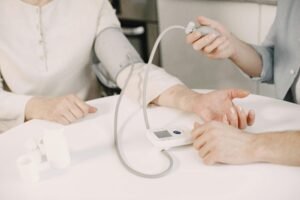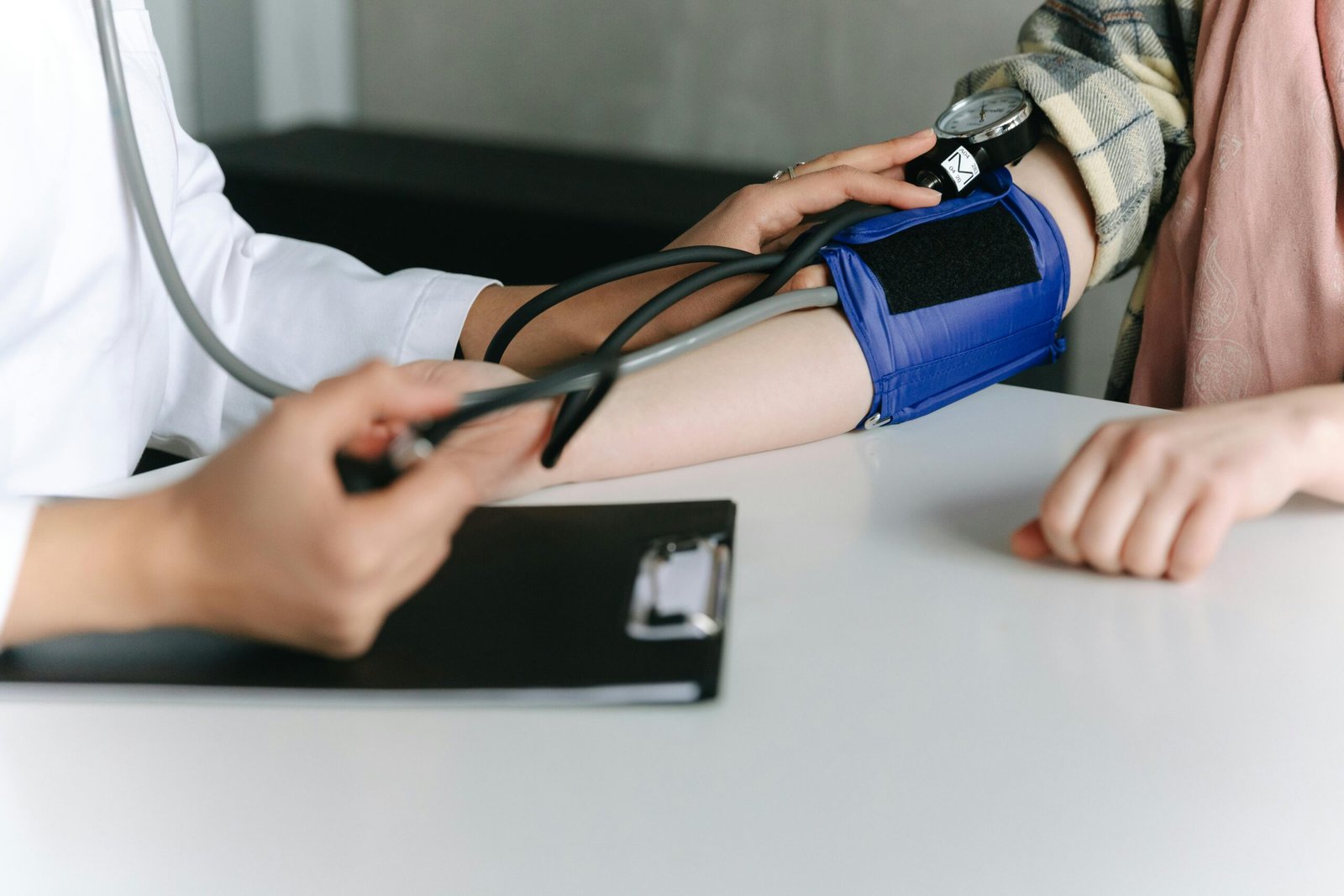What Is High Blood Pressure

High Blood Pressure means is the force exerted by circulating blood against
the walls of arteries.It’s measured in milli meters of mercury (mmHg) and
consists of systolic pressure (when the heart contracts) and diastolic
pressure (when the heart relaxes). Normal blood pressure maintains
vital organ perfusion; abnormal levels can lead to health complications.
Contents ↓
- Understanding Blood Pressure
- Types of Blood Pressure
- Effects of High Blood Pressure
- Symptoms and Diagnosis
- Prevention
Understanding Blood Pressure
- Systolic Blood Pressure
- Diastolic Blood Pressure
- Measurement Units and Normal Range
Systolic Blood Pressure:
Systolic blood pressure represents the maximum pressure exerted
by the heart as it pumps blood through the arteries with
each beat of the heart. This is the highest level in a blood
pressure reading and is measured in milli meters of mercury(mmHg).
Elevated systolic pressure is a risk factor for cardiovascular disease.
Diastolic blood pressure:
Diastolic blood pressure is the lowest pressure in the arteries
as long as the heart relaxes between beats. This is the bottom
number on the blood pressure reading and is measured in milli
meters of mercury (mmHg) Elevated diastolic pressure can be an
indicator of atherosclerosis (promotion of the process that is caused
by a plaque while plaque is being built up) and also increasing the risk
of heart attack and stroke.
Measurement Units and Normal Range:
Blood pressure is measured in milli meters of mercury (mmHg),
with two numbers representing systolic rather than diastolic
pressure. Normal blood pressure is usually 120/80 mmHg.
There are variations based on age, health status and personal
factors, regular inspections help detect deviations from the norm.
Types of Blood Pressure
- Normal Blood Pressure
- Hypertension (High Blood Pressure)
- Hypotension (Low Blood Pressure)

Normal blood pressure
Normal blood pressure normally falls around 120/80
milli meters (mmHg) in the cross section. This means a
heart pressure of 120 mmHg (when the heart is contracting)
and a diastolic pressure of 80 mmHg (when the heart is at rest).
Maintaining blood pressure at this level is important
for overall cardiovascular health and function.
Hypertension (High Blood Pressure)
High Blood Pressure Awareness, occurs when the force
exerted by blood on the artery walls gradually increases.
It is a major risk factor for heart disease, stroke and kidney failure.
Hypotension (Low Blood Pressure)
The symptoms of hypertension/hypotension include blood pressure
becoming primarily high/low. If blood pressure is lower on a regular
basis than the normal measurements of 90/60 mmHg. You may experience
things such as dizziness, ignorance about it, discouragement and general
lack of interest. Dehydration, heart disease and arthritis are the main reasons
for an increased risk of high blood pressure. The treatment is determined by
the cause and the severity of the symptom.
Effects of High Blood Pressure

Cardiovascular Complications:
Cardiovascular cases accompanied by heart and the blood vessels harm.
Such diseases are cardiovascular disease, heart attack and congestive disease
of heart. The risk of congestive heart failure, heart attacks, and peripheral arterial
diseases. The disease develops usually under conditions such as high blood
pressure and high cholesterol or other diseases that narrow or damage arteries.
Management is a crucial factor to lower risk variables in cardiovascular.
Organ Damage:
Some of the damage done to the organs is their organelles gone and their functions
not as normal as before, as well as determining causes for various organs including
injuries, deaths, traumatic accidents, internal bleeding or even vehicle collisions, vital
organs examination is necessary for protracted strain. The head containing brain,
kidney, liver and lungs are separated from the heart which plays a vital role in blood circulation.
Stroke:
Generically, a stroke is an abrupt deprivation of blood supply that leads
to loss of function or brain death. The failure in the route of blood to the brain,
thus symptomizing brain dysfunction. This disorder, which is often triggered by
a clogged artery, leads to nutrient deprivation for the affected tissues.
(ischemic stroke) or (hemorrhagic stroke) when a blood vessel either ruptures
(ischemic stroke) or supplies abnormal blood clot (hemorrhagic stroke), will
invariably disrupt (ischemic stroke) or the delivery (hemorrhagic stroke) of
oxygen to the brain causing tissue damage or death. trigger a huge assortment
of nervous system related conditions, ranging from paralysis.
Kidney Disease:
High blood pressure consciousness campaign would have relevance to the
kidney diseases issues too can have a huge influence on the interaction of
blood pressure. If kidneys are not functioning properly ( they do not perform
their functions properly), then this may result in manifesting of the disorder
called ( that is name of the syndrome). frequently experience the problem of
inadequate self-sustaining system of the electrolyte balance. That directly triggers
the development of hypertension (high blood pressure). Kidney disease
relates to diseases of the urinary system when the kidneys fail to perform
their functions properly. Technically, it may be facilitated by different kinds
of elevating factors known as diabetes, high blood pressure, infectious diseases,
auto-immune diseases etc. Treatment includes lifestyle changes, drugs, dialysis,
or kidney transplants are some of the processes that save the lives of patients.
Symptoms and Diagnosis of High Blood Pressure
Symptoms of High Blood Pressure:
- A sudden, severe headache
- Difficulty in breathing
- Severe pain in abdomen, chest or back
- Numbness or weakness
- Blurred vision
- Frequent Urination
- Nosebleeds
Silent Killer: Often Asymptomatic
The term “silent killing” often refers to medical conditions
such as high blood pressure or certain cancers, which can cause
serious harm without showing obvious symptoms, especially in the early stages.
Diagnostic Tests
Primary diagnosis of high blood pressure (hypertension)
is usually based on repeated blood pressure
measurements. Hypertension is diagnosed when:
Systemic blood pressure (SBP) remained 130 mmHg
Diastolic blood pressure (DBP) was maintained at 80 mm Hg at all times.
The findings can be further classified according to the severity of hypertension:
Stage I blood pressure: SBP 130-139 mm Hg or DBP 80-89 mm Hg.
Stage 2 High blood pressure: SBP 140 mm Hg or higher or DBP 90 mm Hg or higher.
1. Maintain a Healthy Weight
Test that you carry a healthy level of weight by following the recommendations for that purpose.
mass index (BMI) which is in the category of normal/recommended range of 18. 5 to 24. 9 kg/m2.
2. Follow a Balanced Diet:
Consume a diet that is effectively and inexpensive, but give more preferences to
fruits and vegetables, whole grains, bean and lean types of meat and low-fat dairy products.
Decrease sodium consumption levels by minimizing consumption of processed products,
and canned foods. Increase potassium-rich foods like these fruits, such as bananas, spinach
and also sweet potatoes, since potassium helps equalize the levels of sodium.
3. Limit Alcohol:
Drinking moderately is said to be drinking no more than one alcoholic drink a day, this is
particularly for men. yet a woman should have no more than one drink per day and the
limit for men is two drinks per day. Chronic alcohol in excess is capable of increasing
blood pressure significantly.
4. Cease smoking:
Nicotine, the active ingredient in tobacco injuriously affects blood vessels and is a
risk factor for different cardiovascular diseases of hypertension. Smoking quitter
shows a very positive trend in health outcomes. Cardiovascular disease risk is
reduced while blood pressure is acting as the main indicator.
5. Regular Physical Activity:
Maintain a regular exercise schedule of at least 150 minutes of moderate-intensity
aerobic cardio, exercise or 150 minutes of intense exercise weekly, remain dominant
among physicians and researchers when advising patients and developing treatment plans.
In order to sum up, this will consequently involve muscular strength training of at least two days.
days per week. Regular training of one’s organism perfectly conducts lowering of the blood pressure.
improves overall cardiovascular fitness.
6. Reduce Stress:
Practicing some of the stress-reducing ones including deep breathing.
maybe you experience calmness through mediation, yoga, or tai chi.
Chronic stress is an important factor of long-term stress in combination
with other activities.
7. Get Enough Sleep:
Ensure sufficient rest: Go for 7-9 hours of night-long quality sleep every day.
Issues like inadequate and low quality sleep can be the cause of increased
blood pressure increased blood pressure in small children and adolescents.
8. Monitor Blood Pressure:
Check your blood pressure practically at home, with the frequency even more
than your doctors at their clinic recommend you. Whereas if you have risk factors
of hypertension discover more essay examples on health that is helpful not just
only to keep tabs on but also to show progress.
Conclusion :
Such as adopting active lifestyle and introducing healthy patterns one will be
able to reduce the negative impacts that those chronic diseases bring about.
options of their path can remark the chances to avoid the hypertension.
They choose and try to make an improvement to their own lifestyle and as
a result, their chances of going down with hypertension are decreased.
https://absoluteinformation.com/8-health-benefits-of-good-sleep/#more-6425


1 thought on “High Blood Pressure Awareness”